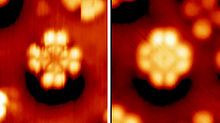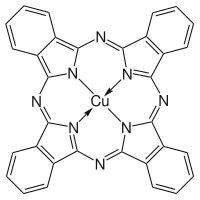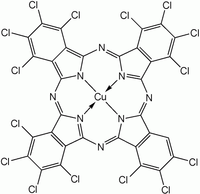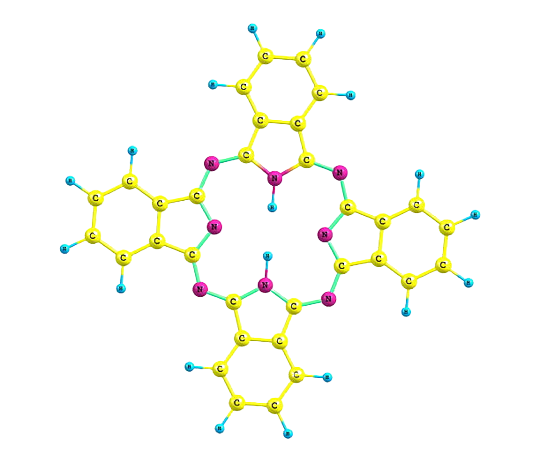
Phtalocyanine
Phthalocyanine (H2Pc) is a large, aromatic, macrocyclic, organic compound with the formula (C8H4N2)4H2 and is of theoretical or specialized interest in chemical dyes and photoelectricity. It is composed of four isoindole units[a] linked by a ring of nitrogen atoms. (C8H4N2)4H2 = H2Pc has a two-dimensional geometry and a ring system consisting of 18 π-electrons. The extensive delocalization of the π-electrons affords the molecule useful properties, lending itself to applications in dyes and pigments. Metal complexes derived from Pc2− , the conjugate base of H2Pc, are valuable in catalysis, organic solar cells, and photodynamic therapy.
- Overview
- Applications
- Properties
Overview
Phthalocyanine is formed through the cyclotetramerization of various phthalic acid derivatives including phthalonitrile, diiminoisoindole, phthalic anhydride, and phthalimides. Alternatively, heating phthalic anhydride in the presence of urea yields H2Pc. Using such methods, approximately 57,000 tonnes (63,000 Imperial tons) of various phthalocyanines were produced in 1985. More often, MPc is synthesized rather than H2Pc due to the greater research interest in the former. To prepare these complexes, the phthalocyanine synthesis is conducted in the presence of metal salts. Two copper phthalocyanines are shown in the figure below.
Halogenated and sulfonated derivatives of copper phthalocyanines are commercially important as dyes. Such compounds are prepared by treating CuPc with chlorine, bromine or oleum.
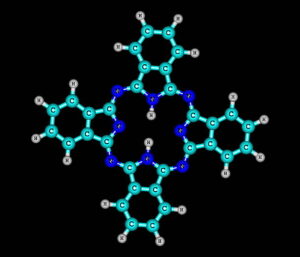
Applications
At the initial discovery of Pc, its uses were primarily limited to dyes and pigments. Modification of the substituents attached to the peripheral rings allows for the tuning of the absorption and emission properties of Pc to yield differently colored dyes and pigments. There has since been significant research on H2Pc and MPc resulting in a wide range of applications in areas including photovoltaics, photodynamic therapy, nanoparticle construction, and catalysis. The electrochemical properties of MPc make them effective electron-donors and -acceptors. As a result, MPc-based organic solar cells with power conversion efficiencies at or below 5% have been developed. Furthermore, MPcs have been used as catalysts for the oxidation of methane, phenols, alcohols, polysaccharides, and olefins; MPcs can also be used to catalyze C–C bond formation and various reduction reactions. Silicon and zinc phthalocyanines have been developed as photosensitizers for non-invasive cancer treatment. Various MPcs have also shown the ability to form nanostructures which have potential applications in electronics and biosensing. Phthalocyanine is also used on some recordable DVDs.
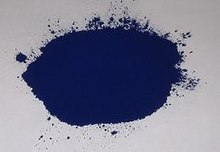
Properties
Phthalocyanine and derived metal complexes (MPc) tend to aggregate and, thus, have low solubility in common solvents. Benzene at 40 °C dissolves less than a milligram of H2Pc or CuPc per litre. H2Pc and CuPc dissolve easily in sulfuric acid due to the protonation of the nitrogen atoms bridging the pyrrole rings. Many phthalocyanine compounds are, thermally, very stable and do not melt but can be sublimed. CuPc sublimes at above 500 °C under inert gases (nitrogen, CO2). Substituted phthalocyanine complexes often have much higher solubility. They are less thermally stable and often can not be sublimed. Unsubstituted phthalocyanines strongly absorb light between 600 and 700 nm, thus these materials are blue or green. Substitution can shift the absorption towards longer wavelengths, changing color from pure blue to green to colorless (when the absorption is in the near infrared). There are many derivatives of the parent phthalocyanine, where either carbon atoms of the macrocycle are exchanged for nitrogen atoms or the peripheral hydrogen atoms are substituted by functional groups like halogens, hydroxyl, amine, alkyl, aryl, thiol, alkoxy and nitrosyl groups. These modifications allow for the tuning of the electrochemical properties of the molecule such as absorption and emission wavelengths and conductance.
